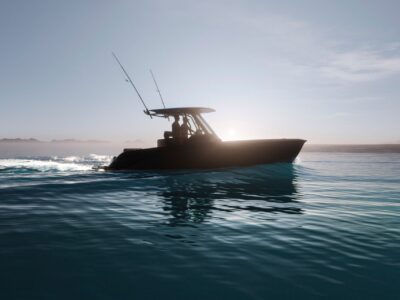(Bloomberg) —
Robots, 3D printers and other machinery fill a building on a pier in San Francisco. It seems an unlikely place to save coral reefs from climate change.
But over the past four years, an Australian coral scientist has been collaborating with technologists at the industrial design software company Autodesk Inc. to develop artificial-intelligence-powered robots that can automate coral restoration. Doing so could speed the rehabilitation of reefs as well as the transplanting of corals to places where they’d have a better chance of surviving in a rapidly warming ocean.
“Where we can really assist is in creating seed banks, because I do think a lot of the tropical corals are going to struggle to survive under climate change,” says coral biologist Taryn Foster, the founder of Coral Maker, who’s working with Autodesk roboticists on the project. Coral Maker, a startup in Geraldton, Australia, aims to eventually restore 100 hectares (250 acres) of reefs a year, compared with the 1 hectare currently rehabilitated annually. Worldwide, coral reefs cover 28.4 million hectares of the ocean.
This summer’s unrelenting climate-change-driven heat cooked coral reefs in Florida, where water temperatures reached 101F (38.3C). In Australia a 2022 marine heat wave affected 91% of the corals surveyed in the Great Barrier Reef. It was the fourth mass bleaching event to devastate the world’s largest reef system since 2016, with water temperatures around the reef hitting a record high last November.
Corals rely on algae to supply food and color. But when ocean temperatures exceed corals’ heat tolerance, the symbiotic algae turn toxic and are expelled. Deprived of nutrition, corals turn white and can die unless waters cool.
Jessica Levy, director of restoration at the Coral Restoration Foundation, says temperatures in the Florida Keys have been so extreme this summer that at one site, corals “didn’t have time to bleach—they just kind of burned and were dead.” So dire was the threat that, in early August, Levy’s colleagues rescued 1,500 corals representing unique genotypes and transported them to water tanks on land to safeguard the reef’s genetic diversity.
As climate change accelerates, it’s leaving almost no reef untouched. Coral restoration has become a contentious issue among marine scientists. Terry Hughes, a prominent coral scientist in Australia, argues that restoration has little impact, is exorbitantly expensive and distracts from reducing carbon emissions, overfishing and pollution, all of which degrade coral reefs. “What would that tiny area look like after it was ‘restored’ and after the next bout of record-breaking temperatures?” Hughes asks of Coral Maker’s 100-hectare goal.
Half of the planet’s reefs—on which 25% of marine species depend—have disappeared over the past 60 years. In 2020 scientists at the University of Hawaii estimated that most of the remaining reefs could be gone within the next two decades, with extinction likely by the turn of the century unless carbon emissions are eliminated. With emissions at record highs, though, and the fate of reefs in the balance, there’s an increasingly pressing need to look for novel solutions to give corals a fighting chance. Projects such as Coral Maker are not designed to replace all the corals lost, but to preserve the genetic diversity of the species.
Foster was a fellow at the California Academy of Sciences in San Francisco in 2019 when she was accepted as a resident at the Autodesk Technology Centers Outsight Network. The program gives entrepreneurs access to design and fabrication tools and to the company’s technology experts.
Efforts to restore reefs have centered on the painstakingly slow and expensive process of hand-transplanting nursery-raised corals in the ocean. Rehabilitation costs vary widely, ranging from $50,000 to $1 million a hectare, according to a paper Hughes co-authored that was published in June in the journal One Earth. “The cost we’re aiming to reduce is the labor cost of doing extremely repetitive and simple tasks that we don’t really need a person to be doing,” Foster says.
That work often involves epoxying individual corals or coral fragments to a degraded reef or gluing the corals into plugs that are inserted into a frame, called a skeleton, that’s then placed in the ocean or attached to an existing reef.
Foster is experimenting with the mass-manufacturing techniques she learned at her family’s stone products business in Western Australia to produce millions of artificial skeletons to hold coral fragments. (The skeletons are made of recycled stone waste.)
Automating the work of placing coral into the skeletons meant training a robot to recognize coral fragments and then pick up the pieces and insert them into a plug. “That’s a big challenge, as you can see that each coral piece is very different from the other, and they’re also very fragile,” says Yotto Koga, a roboticist at the Autodesk AI Lab who volunteered his time for the project.
At Autodesk’s technology center in San Francisco, the team put its AI to the test using a collection of coral that included both real and 3D-printed facsimiles. The AI part of the equation involves training robots to recognize different kinds of coral fragments and adjust their grip accordingly so they don’t damage the organism. Autodesk’s bots resemble pint-size versions of the giant one-armed robots used to weld automotive frames. “Each individual coral is a unique shape, and it’s not something that we could preprogram the robot to handle, so it’s got to be able to deal with that variability on its own,” Foster says.
Her plan is to deploy the robots in two locations. At land-based nurseries, robots would prepare millions of coral plugs for transplantation. Then on a boat at a restoration site, other robots would insert six to eight plugs into each coral skeleton. Divers or remote-operated vehicles would then place the skeletons on a damaged reef or where a new reef was being assembled.
Coral Maker intends to make money in part by selling “biodiversity credits” for reefs it restores or installs. Like carbon credits, biodiversity credits would allow corporations to meet environmental goals by financing ecological preservation. Some experts are concerned, though, that the credits could allow companies to greenwash their role in biodiversity loss unless the offsets are based on sound science, similar to what’s happened with carbon credits.
Foster says only restoration projects that add to biodiversity would generate credits, and rules would be put in place to prevent corporations from “just using them to get the green light to do further damage.”
Although the robots were able to perform restoration tasks in the controlled conditions of the Autodesk laboratory, the next step is to test their ability in the real world with live corals. “If you’re doing computer vision, lighting conditions are really material,” says Heather Kerrick, an Autodesk robotic systems expert. “But we can’t simulate the lighting conditions of a Western Australia beach in here.”
Even the most ambitious restoration effort would be but a drop in an ever-hotter ocean given the extent of coral loss. Hughes and his co-authors analyzed 323 coral reef studies and reports and found that planting 1 billion corals, each 1 square foot in size, would increase coral cover in the Great Barrier Reef by only 1%.
Levy of the Coral Restoration Foundation says that automation and robotics could scale up reef rehabilitation but that the goal of such efforts isn’t necessarily to replace what’s been destroyed. “The point of restoration is population persistence, maintaining these corals from going extinct,” she says. “Not everything we put back in the water is going to survive changing temperatures. But if we do nothing, there will be nothing left.”
To contact the author of this story:
Todd Woody in San Francisco at twoody4@bloomberg.net
© 2023 Bloomberg L.P.





